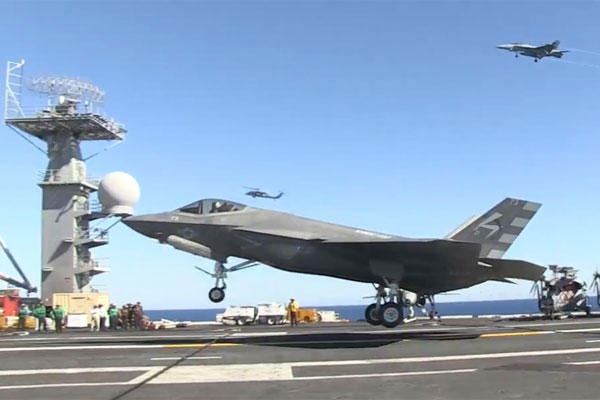The Navy's F-35C Joint Strike Fighter carrier variant conducted its first arrested landing Nov. 3 aboard the USS Nimitz off the coast of San Diego, California, service officials said.
The arrested landing on board the Nimitz aircraft carrier is part of initial at-sea developmental testing for the F-35C -- testing which is expected to last two weeks, Navy leaders said.
"Today is a landmark event in the development of the F-35C," Navy Cmdr. Tony Wilson, a test pilot with Air Test and Evaluation Squadron, said in a written statement. "It is the culmination of many years of hard work by a talented team of thousands."
The goal of the initial testing is to collect environmental data through added instrumentation to measure the F-35C's integration to flight deck operations and to further define the F-35C's operating parameters aboard the aircraft carrier, a Navy statement said.
The test team will analyze data obtained during flight test operations, conduct a thorough assessment of how well the F-35C operated in the shipboard environment, and advise the Navy to make any adjustments necessary to ensure it is ready to deploy to the fleet in 2018.
"Our F-35 integrated test team has done an amazing job preparing for today. This will be one landing out of thousands more that will happen over the next few decades," said Lt. Gen. Chris Bogdan, F-35 program executive officer.
"We plan on learning a lot during this developmental test and will use that knowledge to make the naval variant of the F-35 an even more effective weapons platform."
The F-35C is engineered to be larger than the Air Force's F-35A or Marine Corps short-take-off-and-landing F-35B because the structure of the aircraft needs to be able to withstand the impact of landing on a carrier. Also, the F-35C has larger, foldable wings to facilitate slower approach speeds compatible with moving ships, Navy officials said.
brightcove.createExperiences();
"In order to withstand the forces experienced during an arrested landing, the keel of an F-35C is strengthened and the landing gear is of a heavier-duty build than the A and B models," an official with the F-35 Integrated Test Force said.
The wings of the F-35C are also built with what's called "aileron control surfaces" designed to provide control power to roll the aircraft at slow approaching speeds, Wilson told Military.com earlier this year.
At sea, pilots must account for their speed as well as the speed of the wind, the weather, or visibility conditions as well as the speed of the boat, Wilson explained.
"The landing area is constantly changing. This is a challenge to structure of the aircraft because there is no way of knowing for certain how hard we are going to hit the deck or at what angle they are going to be at," he added.
On an aircraft carrier, the ship has arresting wires or metal cables attached to hydraulic engines used to slow the aircraft down to a complete stop within the landing area.
"On an aircraft carrier, the landing area is off about 10-degrees. The boat's motion itself is moving away from you — so you can't just aim at the boat," Wilson said.
The cable is four to six inches above the deck of the carrier and hydraulic fluid controls the pace of deceleration for the aircraft, Wilson said. A hook lowers from the back end of the F-35C aircraft, designed to catch the cable and slow down the plane.
"In order to maintain our stealth configuration, we had to put the hook internal to the airframe. On all the legacy systems, the tail hook sits up underneath the engine externally. We have three doors that open up to allow the tail hook to fall down," Wilson said.
The aircraft also needs to be able to withstand what's called a "free flight," a situation where the pilot receives a late wave off to keep flying after the hook on the airplane has already connected with the wire, he explained.
"We need to be sure that the engine and the aircraft itself can handle the stress of essentially being ripped out of the air by the interaction between the cable and the hook," Wilson added.
Describing landing as a controlled crash into the aircraft carrier, Wilson explained that pilots look at a light on the ship called the Fresnel Lens in order to orient their approach.
By 2025, the Navy's aircraft carrier-based air wings will consist of a mix of F-35C, F/A-18E/F Super Hornets, EA-18G Growlers electronic attack aircraft, E-2D Hawkeye battle management and control aircraft, MH-60R/S helicopters and Carrier Onboard Delivery logistics aircraft, service officials said.
-- Kris Osborn can be reached at kris.osborn@monster.com





























